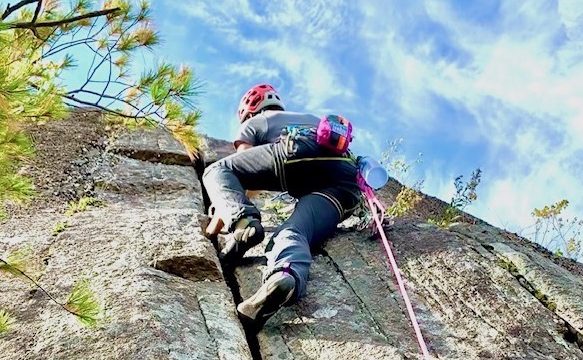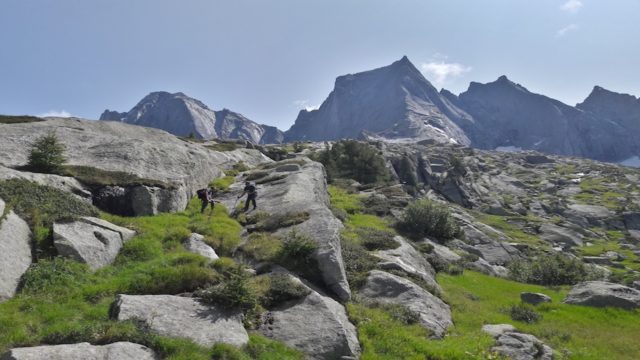When I was a kid I was fascinated by the movie Lawrence of Arabia with Peter O’Toole. In the film, set during the First World War, T.E. Lawrence teamed up with the Arabs to lead an army across the arid brick-red sand of the desert to launch a rebellion on the Turks. After watching the film I loved learning about that region of the world. I marveled at the incredibly rich, diverse culture, tumultuous history and unique landscape of the Middle East. So, when I was offered an opportunity to come speak to a group in Dubai and Jordan, I jumped at the chance. Of course, it was also a perfect excuse to pair it with a climbing trip to the Jordanian valley of Wadi Rum. Also known as the valley of the moon, Wadi Rum features dramatic sandstone formations jutting steeply from the desert sands.

For my eight-day trip, I had my own “Lawrence,” Rob Raker, my long-time friend and climbing partner. Rob and I have been on climbing adventures around the world from the Himalayas to the Czech Republic to Taiwan. With Rob at my side, I felt confident that I could tackle whatever challenges we might encounter.

But Rob was more apprehensive about our trip. About ten years ago Rob had received a devastating Stage IV prostate cancer diagnosis. It was extremely aggressive and he went through rounds of radiation, and surgeries to remove his prostate and eighteen surrounding lymph nodes in his pelvis. He’d been on a journey of recovery but, just recently, had bone tumors appear. These new developments, along with new powerful hormone treatments, caused significant muscle loss, and left him with little testosterone and waning energy.
The idea of going to an isolated area like Wadi Rum, with uncertain medical support, had Rob nervous. But his spirit and love of climbing enable him to thrive and keep going. This was going to be a challenging and rewarding trip for us both.

Rob and I met up with some friends – longtime climbing partner Timmy O’Neill, Dr. Geoff Tabin of the Himalayan Cataract Project, and his wife, Dr. In-Hei Hahn, and our photographer buddy, James Q. Martin – known as Q, who captured the still images on my Grand Canyon kayak descent and happens to be a very good climber, so we were lucky to have him with us. He took some pretty spectacular images using his drone, which I could hear buzzing around us and cutting through the winds as we scaled the sheer walls.

The red Martian landscape of Wadi Rum is one of the driest places on earth, belying its history as an ancient seabed. Over time, uplift and erosion shaped enormous sandstone buttresses, some miles-long, that jut out of the sandy desert floor in complex and improbable formations. They have everything from knife-edge ridges to big, flat plateaus with vegetation growing up out of the top, each one with its own microbiome.

Only recently discovered by Westerners as a climbing destination, the area still holds an ancient and isolated feel. Long before the invention of sticky rubber shoes and protective camming devices, the Bedouin Arabs would essentially free-solo the tall towers, climbing without the use of ropes, ladders or protection, in search of wild goats. Even crazier, they would climb down, too! Imagine the sight of a barefooted man downclimbing some of the hardest routes, carrying a dead goat over his shoulders.


Wadi Rum is a labyrinth of canyons and towers where it is very easy to get off course and so our secret weapon was a local guide named Marwan. He is a formidable, well-known local climber who provided very helpful regional knowledge. The featureless sandstone makes for difficult climbing for a blind guy, and what cracks and seams exist often lead in the wrong direction, so Rob’s precise beta was critical to help me move efficiently. “So, when you get up here a little bit further, you’re going to lift your right leg a little higher and there’s some great pocket holds on the left.” … “Come up with your hand, down a little bit, to the right, and I know it’s not much but it’s a good place to stem with your foot.” … “Ok, over to the right and now you can find the crack more over to your right – nice dude! Well done!”


Our host, Mohammed Hussein, put us up at one of the many desert Bedouin camps that had tents with traditional woven walls and cots set up inside, and a central dining area where we ate on the floor layered in different rugs. It was somewhat like an Army barracks . . . but with amazing food. Mohammed showed us wonderful hospitality, taking us out each day in his truck outfitted with benches on the flatbed, to different climbs in the area and, at night, fantastic meals were prepared for us like Mansaf, a traditional rice and lamb or chicken dish with yogurt sauce. The cooking style was simple, but bursting with flavor from local spices like harissa that has a sweetly spicy chili taste and savory cumin that reminded me of falafel sandwiches from a NYC street cart.

We ended up climbing different routes every day. Before meeting the rest of the team, Rob and I started with a recommendation from Timmy’s friend, James Garrett, who had completed a first ascent of a 6-pitch mega-route called “The Face.” I’ve climbed a heck of a lot of faces, but this one was unique due to its variety and the sheer terror invoked by the fragile, loose sandstone holds. While navigating the thin cracks and steep headwalls of the route, I had to be judicious about what I was cranking on; if I pulled too hard, the brittle sandstone would simply crumble in my fingers! It was crucial to maintain 3 points of contact at all times in case anything underhand or underfoot snapped unsuspectingly. This sketchy terrain definitely keeps you awake while you are moving.

After the climbing, our real adventure that day began on the descent. We were vaguely instructed to “turn left and find our way down.” We found ourselves hiking and downclimbing through slot canyons that would drop suddenly into space. I was very grateful I had Rob with me – his sense of direction and orienteering skills are what got us back down safely, through sheer cliff bands, across slippery, sandy ledges, and tight canyons.

We made sure to also hit classic routes like “Merlin’s Wand,” a stunning 4-pitch crack climb. We started early in Barrah Canyon, which was north facing and surprisingly freezing. The stereotype of the Jordan desert is that it’s blazing hot, but that’s not true in December. Daylight is a problem too, especially for those with eyeballs. Darkness falls by 4:45PM and it would turn bone-chillingly cold. Despite wearing our down jackets, we shivered as we ascended the climb but it was worth it; we relished the opportunity to be cold in this wondrous place.

Later in the trip, we headed up the aptly named route “The Beauty.” Getting there seemed to be the crux. Timmy said that when you look around, there’s virtually nothing to orient you; it’s all rock walls and sky, like being enclosed in a fortress of sandstone ridges. We were never quite sure if we were on track as we dipped into slot canyons, hiking up and over rises and negotiating the orange labyrinth. We were marooned travelers, borne on our feet through a land trodden by marauders and mercenaries. This was the adventure I had come for, in a way; the challenges made the summit that much sweeter.

Eventually, mercifully, we made it to the base and 5 pitches later pulled ourselves onto the summit, a big flat plateau of soft baked mud embedded with river rocks that were perfectly smooth, round, and white translucent quartz; the mud was so soft you could pluck the stones right out of it!

All the climbing was incredible, culminating on our final day, when we climbed “Bedouin Camel Boys.” The route is unique because the approach was just a short hike up and over a sand dune, a strong contrast to the involved adventures of the previous days. We crested the dune, and suddenly there it was – a huge orange pillar just jutting out of the sand, a crack climbing oasis in the middle of the desert. At the top, we spent some time enjoying our moment on the cool summit, reflecting on how lucky we felt to climb in this alien landscape.


Of course, our trip had some non-climbing highlights too. We swam, or rather floated in the Dead Sea, which at 33% salinity is dropping at a rate of 1 meter per year. It feels like an anti-gravity bath. You hop in and bob like a cork and after your swim, you emerge a salty sea monster, coated in a layer of white flaky minerals. But, my skin felt smoother – I can see why people from around the world come for a spa-like experience.

My most treasured memory of the trip was a rest day we spent with Mohammed, traveling from our camp to his house by camel and hanging at his house where I met his two children and drank fragrant Turkish coffee. At the end of the day, Mohammed offered me his long beautiful Bedouin coat and gold, green and black color headscarf.



I was taken aback, not wanting to accept his prize possession, but Mohammed insisted. He taught me the proper way to tie the headscarf, a specific multi-step folding, tying, and tightening process. People use the expression, “he’d give you the clothes off his back,” but Mohammed actually did this. I was blown away and only hope I can take this incredible generosity with me and pass it on to friends and strangers.

Now that I am back home it’s easy to think of Wadi Rum as just a distant magical landscape and an extraordinary opportunity to immerse myself in a fabled land. But, when I roll the smooth desert rocks in my hand or practice wrapping the headscarf Mohammed gave me, I recall more.

I remember the freedom I felt high on those desert walls and of the way Rob and my team led me fearlessly through unknown terrain. I remember the different ecosystems that had been crafted over centuries of geological change. Whether it is the fast shrinking Dead Sea or the erosion of rock in the desert, most things become sand eventually. But what is left is the hard stuff, the essence. It is the same with people. We experience adversity and it can reduce us and even leave scars, but we keep moving forward and adapting.

For Rob, his cancer diagnosis robbed him of some of his physicality; he had been a world-class athlete. But ultimately, the essence of Rob, his love for exploration and adventure, his loyalty and devotion, and his desire to ingest as much as life can possibly offer, is as clear and striking as the formations that rise up out of that sand.
Photo Credits: James Q Martin







